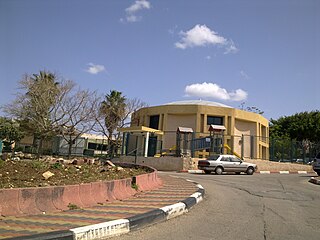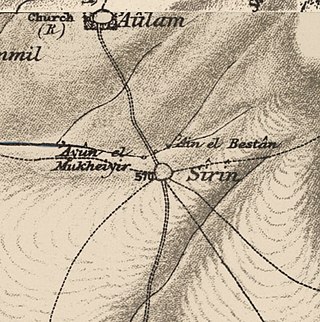
Petra, originally known to its inhabitants as Raqmu, is a historic and archaeological city in southern Jordan. Famous for its rock-cut architecture and water conduit systems, Petra is also called the "Rose City" because of the colour of the sandstone from which it is carved. The city is one of the New 7 Wonders of the World and a UNESCO World Heritage Site.

The Mausoleum of Khawaja Ahmed Yasawi is a mausoleum in the city of Turkestan, in southern Kazakhstan. The structure was commissioned in 1389 by Timur, who ruled the area as part of the expansive Timurid Empire, to replace a smaller 12th-century mausoleum of the famous Turkic poet and Sufi mystic, Khoja Ahmed Yasawi (1093–1166). However, construction was halted with the death of Timur in 1405.

Konye-Urgench, also known as Old Urgench or Urganj, was a city of about 30,000 inhabitants in north Turkmenistan, just south from its border with Uzbekistan. It is the site of the ancient town of Gurgānj, which contains the ruins of the capital of Khwarazm. Its inhabitants deserted the town in the early eighteenth century in order to develop a new settlement, and Konye-Urgench has remained undisturbed ever since. In 2005, the ruins of Old Urgench were inscribed on the UNESCO List of World Heritage Sites.

The Chellah or Shalla, is a medieval fortified Muslim necropolis and ancient archeological site in Rabat, Morocco, located on the south (left) side of the Bou Regreg estuary. The earliest evidence of the site's occupation suggests that the Phoenicians established a trading emporium here in the first millennium BC. This was later the site of Sala Colonia, an ancient Roman colony in the province of Mauretania Tingitana, before it was abandoned in Late Antiquity. In the late 13th century the site began to be used as a dynastic necropolis for the Marinid dynasty. By the mid-14th century Marinid sultans had enclosed a part of the site with a new set of walls and built a religious complex inside it to accompany their mausoleums. In the 15th century the necropolis began to decline and it suffered damage over the centuries due to earthquakes and looting. Archeological excavations in the 20th century unearthed the remains of the ancient Roman town. Today the site is a tourist attraction and since 2012 it forms part of a UNESCO World Heritage Site.

Qasr Harrana, sometimes Qasr al-Kharana, Harana, Qasr al-Harrana, Qasr al-Haranah, Haraneh, Khauranee, or Hraneh, is one of the best-known of the desert castles located in present-day eastern Jordan, about 60 kilometres (37 mi) east of Amman and relatively close to the border with Saudi Arabia. It is uncertain when the palace was constructed, but it likely originates from the Umayyad Dynasty. An inscription on an upper wall dates the building to before 710 CE. A Greek or Byzantine house may have existed on the site. The purpose of the building is a subject of debate among scholars. Theories as to the qasr's purpose include a Crusader's castle, a military stronghold, agricultural outpost, and resting place for caravan travelers. The current scholarly consensus is that the building was used as for meeting between local Bedouin leaders.

A mazār, also transliterated as mazaar, also known as marqad (مَرْقَد) or in the Maghreb as ḍarīḥ (ضَرِيْح), is a mausoleum or shrine in some places of the world, typically that of a saint or notable religious leader. Medieval Arabic texts may also use the words mašhad (مَشْهَد) or maqām to denote the same concept.

The Saadian Tombs are a historic royal necropolis in Marrakesh, Morocco, located on the south side of the Kasbah Mosque, inside the royal kasbah (citadel) district of the city. They date to the time of the Saadian dynasty and in particular to the reign of Ahmad al-Mansur (1578–1603), though members of Morocco's monarchy continued to be buried here for a time afterwards. The complex is regarded by many art historians as the high point of Moroccan architecture in the Saadian period due to its luxurious decoration and careful interior design. Today the site is a major tourist attraction in Marrakesh.

Sheikh Dannun ; also transliterated as Sheikh Danun and Sheikh Danon) is an Arab village located in Israel's Northern District. Since 1948, it has been made up of two old villages – Shaykh Danun and Shaykh Dawud – which were merged, and are now jointly referred to as Sheikh Dannun. Located on a hill overlooking the plains of Acre, both of these old villages were built around a tomb for a sheikh, and share a similar history. It falls under the jurisdiction of Mateh Asher Regional Council, and in 2022 it had a population of 3,031.

Chashma-Ayub Mausoleum is located near the Samani Mausoleum, in Bukhara, Uzbekistan. Its name means Job's well, due to the legend in which Job (Ayub) visited this place and made a well by striking the ground with his staff. The water of this well is still pure and is considered healing. The current building was constructed during the reign of Timur and features a Khwarazm-style conical dome uncommon in Bukhara.

Sirin, was a Palestinian Arab village located 17 kilometers (11 mi) north of Beisan. The village was depopulated and destroyed in 1948. Only the village cemetery and one house remain standing, along with the remains of a mosaic pavement and a vaulted spring dating to the Byzantine period. Mentioned in historical documents, the 1596 census indicated it had 45 households; by 1945, the number of inhabitants had risen to 810.

The Tomb of Asif Khan is a 17th-century mausoleum located in Shahdara Bagh, in the city of Lahore, Punjab. It was built for the Mughal statesman Mirza Abul Hassan Jah, who was titled Asif Khan. Asif Khan was brother of Nur Jahan, and brother-in-law to the Mughal Emperor Jahangir. Asif Khan's tomb is located adjacent to the Tomb of Jahangir, and near the Tomb of Nur Jahan. Asif Khan's tomb was built in a Central Asian architectural style, and stands in the centre of a Persian-style Charbagh garden.

The Tomb of Shah Rukn-e-Alam located in Multan, Punjab, Pakistan, is the mausoleum of the 14th century Sufi saint Shah Rukn-e-Alam. The shrine is considered to be the earliest example of Tughluq architecture, and is one of the most impressive shrines in the Indian subcontinent. The shrine attracts over 100,000 pilgrims to the annual urs festival that commemorates his death.

Persian domes or Iranian domes have an ancient origin and a history extending to the modern era. The use of domes in ancient Mesopotamia was carried forward through a succession of empires in the Greater Iran region.

The Zumurrud Khatun Mosque and Mausoleum, also known as the Tomb of Sitta Zubayda, is a historic mosque and shrine located in Baghdad, Iraq. It dates back to the Abbasid era. It is located in Sheikh Ma'ruf Cemetery in the Karkh side of Baghdad, and the site was built at the patronage of Zumurrud Khatun and her son. Zumurrud Khatun was the wife of the 33rd Abbasid caliph, al-Mustadi and mother of Caliph al-Nasir. She collected the waqf money from madrasas and built her mausoleum before her death, which is located in Karkh.

Pir Mardakan Khanqah is historic architectural monument located in the village of Goylar, 16 km south-west of Shamakhi district of the Azerbaijan Republic. The complex includes a tomb, a dynasty building and small auxiliary buildings. It was built in XIII–XIV centuries. According to some sources, this is the tomb of Seyid Mardakani, one of the famous scholars of his time.

The Shrine of Khwaja Abd Allah, commonly called the Shrine at Gazur Gah and the Abdullah Ansari Shrine Complex, is the funerary compound of the Sufi saint Khwaja Abdullah Ansari. It is located at the village of Gazur Gah, three kilometers northeast of Herat, Afghanistan. The Historic Cities Programme of the Aga Khan Trust for Culture has initiated repairs on the complex since 2005.

The architecture of Jordan has been subject to vast development, specifically in the final years of the twentieth century. Jordan is a semi-arid country located in the Middle East. Its location has great significance to Christians, Muslims and Jews as it is considered part of the Holy Land.

The Zawiya of Sidi Bel Abbes or Zaouia of Sidi Bel-Abbès is an Islamic religious complex (zawiya) in Marrakesh, Morocco. The complex is centered around the mausoleum of Abu al-Abbas as-Sabti, a Sufi teacher who died in 1204. He is the most venerated of the Seven Saints of Marrakesh, generally considered the "patron saint" of the city. The zawiya's architecture dates in part to the late Saadian period but has been modified and restored multiple times since then.

Al-Nabi Jirjis Mosque was a historic religious complex consisting of a mosque and mausoleum located in Mosul, Iraq. The person buried in the mausoleum is believed to be that of Saint George, known by Muslim locals as Jirjis.
The Podsho Pirim Complex is an architectural monument located in the village of Bekobod in the Buvaydin district of the Fergana region of Uzbekistan. The complex consists of a graveyard, a mausoleum, a darvaza-khana, and a shrine. The main structure of the complex is the mausoleum of Shah-i Jari. Most of the complex was built in between 15th and 16th centuries, but there are also buildings dating from the 20th century.



















